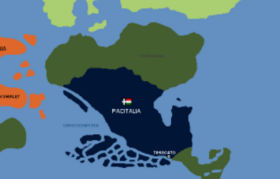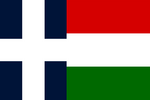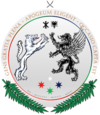Pacitalia: Difference between revisions
No edit summary |
mNo edit summary |
||
| (2 intermediate revisions by the same user not shown) | |||
| Line 5: | Line 5: | ||
| native_name = ''Repubblica Pacitaliana'' | | native_name = ''Repubblica Pacitaliana'' | ||
| image_flag = [[Image:FlagofPacitalia.png|150px]] | | image_flag = [[Image:FlagofPacitalia.png|150px]] | ||
| image_symbol = [[Image: | | image_symbol = [[Image:Pacitalia_Emblem_small.png|100px]] | ||
| symbol_type = | | symbol_type = Seal | ||
| national_motto = ''Semper contendentes''<br>English: Always striving | | national_motto = ''Semper contendentes''<br>English: Always striving | ||
| national_anthem = ''Nessun dorma'' | | national_anthem = ''Nessun dorma'' | ||
| Line 12: | Line 12: | ||
| map_caption = Location of Pacitalia in [[Foringana]], with portions of [[Atlantian Oceania]] visible to the north and west | | map_caption = Location of Pacitalia in [[Foringana]], with portions of [[Atlantian Oceania]] visible to the north and west | ||
| capital = [[Timiocato]] | | capital = [[Timiocato]] | ||
| largest_settlement = | | largest_settlement = [[Saronno]] | ||
| largest_settlement_type = | | largest_settlement_type = city | ||
| official_languages = [[Pacitalian]] | | official_languages = [[Pacitalian]] | ||
| recognized_languages = {{unbulleted list | [[English]] | [[Empordian]] | [[Spanish]]}} | | recognized_languages = {{unbulleted list | [[English]] | [[Empordian]] | [[Spanish]]}} | ||
| Line 26: | Line 26: | ||
| government_type = Parliamentary, semi-presidential republic | | government_type = Parliamentary, semi-presidential republic | ||
| leader_title1 = [[Archonate of the Pacitalian Republic|Archonate]] | | leader_title1 = [[Archonate of the Pacitalian Republic|Archonate]] | ||
| leader_name1 = [[ | | leader_name1 = [[Abeo Bamidele]] | ||
| leader_title2 = [[Prime Minister of the Pacitalian Republic|Prime Minister]] | | leader_title2 = [[Prime Minister of the Pacitalian Republic|Prime Minister]] | ||
| leader_name2 = [[Damián Moya]] | | leader_name2 = [[Damián Moya]] | ||
Latest revision as of 17:59, 1 January 2024
Pacitalian Republic Repubblica Pacitaliana | |
|---|---|
| Motto: Semper contendentes English: Always striving | |
| Anthem: Nessun dorma | |
 Location of Pacitalia in Foringana, with portions of Atlantian Oceania visible to the north and west | |
| Capital | Timiocato |
| Largest city | Saronno |
| Official languages | Pacitalian |
| Recognized languages | |
| Religion (2020) |
|
| Demonym(s) | Pacitalian |
| Government | Parliamentary, semi-presidential republic |
| Abeo Bamidele | |
| Damián Moya | |
| Legislature | Bicameral parliament |
| Senato Repubblicana | |
| Constazione Repubblicana | |
| Country | |
• Settlement by indigenous people | est. 12,000-15,000 BCE |
• Colonization by Roman settlers | 10 CE |
• First Pacitalian Republic | November 21, 1503 |
• Second Pacitalian Republic | December 10, 2007 |
| Area | |
• Total | 4,134,992 km2 (1,596,529 sq mi) (1st) |
• Water (%) | 21.8 |
| Population | |
• 2023 estimate | 422,202,379 |
• 2020 census | 407,230,910 (1st) |
• Density | 120.4/km2 (311.8/sq mi) |
| GDP (PPP) | 2023 estimate |
• Total | $25.384 trillion (1st) |
• Per capita | $60,123 |
| GDP (nominal) | 2023 estimate |
• Total | $42.918 trillion (1st) |
• Per capita | $101,653 |
| Currency | Douro (Ð) |
| Time zone | AOTC +0200, +0300 |
| DST not observed | |
| Driving side | right |
| Calling code | +2 |
| ISO 3166 code | PAC |
| Internet TLD | .pc, .rp |
Pacitalia (officially the Pacitalian Republic; Pacitalian: Repubblica Pacitaliana) is a country in central Foringana. It occupies most of the Foringanan continent, in addition to a vast archipelago of approximately 3,800 islands of various size stretching out into the Carcossian Sea, which separates Foringana from Atlantian Oceania. The country also has jurisdiction over approximately 160 islands off its eastern coast and in the Gulf of Pacitalia. The country shares borders with Scandonia and Medovicia to the north and Drakia to the southeast. Pacitalia's size, and its possession of numerous islands coupled with rugged shoreline, gives it an extensive saltwater coastline of just over 440,000 kilometres in total length.
Initially settled by Indigenous people sometime between 12,000 and 15,000 BCE, Foringana was subsequently discovered by Roman sailors, sent by Caesar Augustus to colonize new lands and find natural resources for the benefit of the Roman Empire. Evidence of Roman shipwrecks near Caderesta on Pacitalia's east coast date to the year 10 CE. Pacitalian territory eventually extended from the Fiume di Timiocato in the south to as far north as present-day Nortopalazzo by the end of the eleventh century. Over the course of the first millennium, Indigenous populations were almost completely wiped out by a combination of war, forced famine, and disease. The government finally acknowledged this as a genocide in 2021 and extended an official apology.
Colonization by Spanish explorers of the lands further north began in the fourteenth and fifteenth century. The Viceroyalty of Marquería and Empordia was established by the King of Spain to entrench Spanish interests on the continent. Tensions between the Viceroyalty and the Pacitalian Free State culminated in the Spanish-Pacitalian War (1481-1499), resulting in the Kingdom of Spain's defeat, the end of the Demarcation. After four years, amid continuing tension, the First Pacitalian Republic, encompassing the current extent of Pacitalian territory, was proclaimed in 1503.
Up until about 1875, Pacitalia was deeply Catholic, conservative, and agrarian, with limited industrialization. It has, over time, evolved into a developed, modern, cosmopolitan, and open nation. A period of substantial immigration to Pacitalia began in the early twentieth century, with tens of millions of new arrivals, predominantly Greeks and Romanians. In the years that followed, the country experienced a so-called Golden Age, characterized by mass industrialization and rapid economic growth. A second wave of immigration began in the late 1970s and has continued to the present day, primarily involving refugees and asylum seekers, and people of African, Asian and Middle Eastern descent. Pacitalia is now home to large Persian and Turkish communities, and, as of 2023, about eight percent of the country's population is Muslim.
The development of Pacitalia's finance, natural resources, shipping, transportation, agriculture, manufacturing, pharmaceutical, tourism, and retail sectors has transformed the country into an international economic power. Pacitalia welcomes hundreds of millions of visitors a year, drawn by the country's tropical climate, culture, and popular cuisine. Today, Pacitalia is one of the wealthiest and most developed countries, with a massive, highly diversified economy, an educated and highly skilled workforce, a high Human Development Index, and steadily decreasing income inequality.
Pacitalia's currency, the douro, is a reliable, stable benchmark currency of global importance. The country has an extensive financial sector, including major stock indices and several large banks. Pacitalia is one of the world's largest net exporters. All three of the largest known hydrocarbon reserves in Foringana are within Pacitalian territory. The country maintains a social market economy.
Modern Pacitalia is secular and liberal. The twentieth and twenty-first centuries have seen sweeping social change that defied Pacitalia's long and complex relationship with Christianity. Abortion was legalized in 1968, while homosexuality was decriminalized in 1970 and then legalized in 1975. Marital benefits and adoption rights were expanded to same-sex couples in 1996. After the turn of the century, Pacitalia legalized same-sex marriage in 2002 and medically-assisted dying in 2008. The country is part of the "Queer Belt", measuring countries where LGBTQ+ people possess significant rights and legal and constitutional protections. Pacitalia does not have capital punishment; the death penalty was abolished in 1984 following a referendum.
Since 2020, a single party, the left-wing Pacitalian Social Democratic Congress, has had majority control of both houses of the Pacitalian parliament. The government is headed by a Prime Minister, Damián Moya. The head of state, the Archonate, exercises a combination of official powers and ceremonial duties. The country's foreign policy is heavily focused on advancing liberal democratic values and gender, racial, and socioeconomic equality. Pacitalia is a leading contributor of aid to the developing world.
Pacitalia is officially a unitary state with a single, national government, seated in Timiocato. However, the country has devolved some of its powers to regional government. In the ethnically distinct regions of Empordia and Marquería in northern Pacitalia, devolution of powers is more extensive. Pacitalia is considered a semi-presidential republic with a parliamentary democracy. The country is multilingual, with Pacitalian as its sole official language, and Empordian, English and Spanish as recognized national languages in common use.

